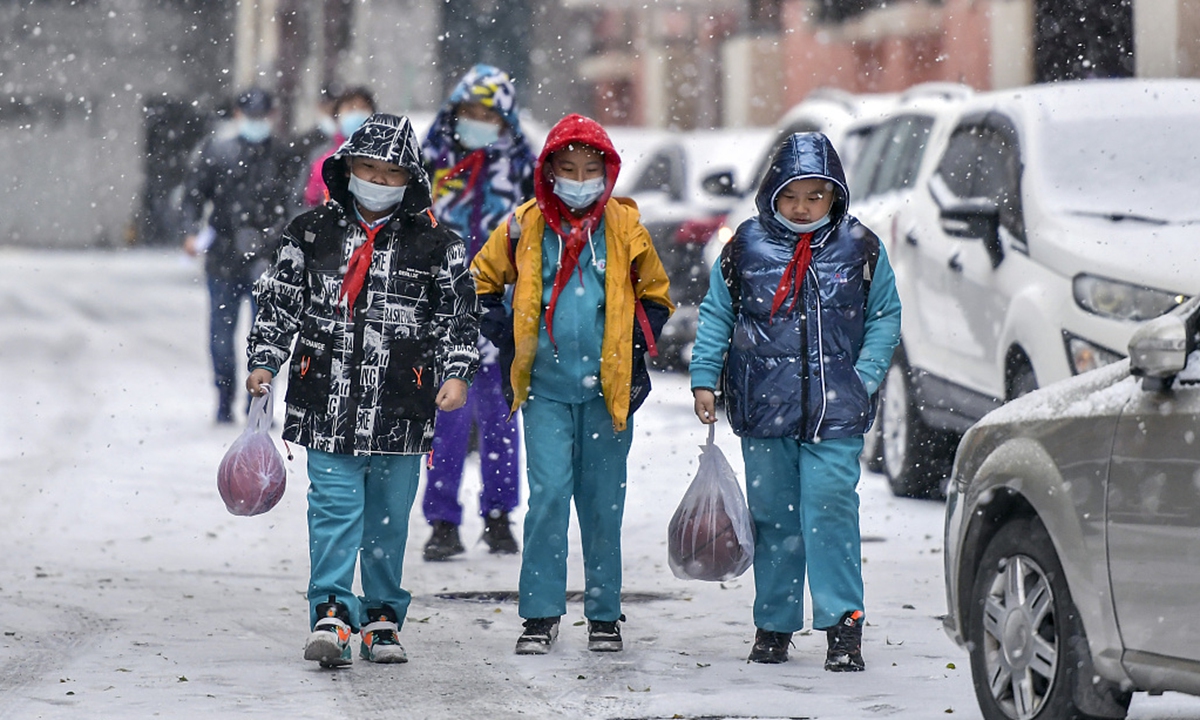China's meteorological office issues alert for temperature drops of up to 16 C; colder winter likely

Snow sweeps Urumqi, capital city of Northwest China's Xinjiang Uygur Autonomous Region on November 4, 2021. Photo: VCG
The China Meteorological Administration (CMA) on Thursday warned that two strong cold waves will hit most of China in the following 10 days, dragging temperatures in some regions down by almost 16 C. A yellow alert (the third severest) has been issued for residents to get prepared.
Except for the northeastern tip of China, the majority of the nation will see temperatures 2-4 C lower than average during the cold waves, and some places are expected to break records for low temperatures.
The two cold waves will drag temperatures in most places down by 8-10 C with a maximum of 16 C. Snow will fall in northern China while rainfall will sweep across the southern part of the nation.
The CMA said that China will see stronger and more frequent cold waves this winter, with temperatures in central and eastern China to be 2 C lower than average, and the nation will experience a La Nina phenomenon.
La Nina doesn't necessarily lead to a cold winter in China, but the chance is higher this time, a Beijing-based expert told the Global Times, noting a La Nina phenomenon caused severe snowstorms and icy rain across the nation in 2008.
Unlike a series of cold waves that cool down the nation gradually, people will experience the quick-freeze effects several times and a cold winter is likely, experts explained, noting that extreme weather is connected to climate change.
The official forecast also said that northern China will see more snow than average and southern China less rainfall than average — the same precipitation pattern seen during the summer.
China saw more frequent extreme weather events in 2021, which severely affected some provinces and regions and disrupted people's lives, the CMA said.
It announced that given the coming cold waves, the Ministry of Emergency Management and the National Food and Strategic Reserves Administration have allocated 237,900 cotton-padded coats and quilts to 13 provinces and regions to support local governments.
The low temperatures could also affect the growth of winter wheat, greenhouse vegetables and the health of poultry and livestock. The Ministry of Agriculture and Rural Affairs has formulated targeted methods to respond to these conditions, the ministry said during a press conference on Thursday.

Snow sweeps Urumqi, capital city of Northwest China's Xinjiang Uygur Autonomous Region on November 4, 2021. Photo: VCG
The China Meteorological Administration (CMA) on Thursday warned that two strong cold waves will hit most of China in the following 10 days, dragging temperatures in some regions down by almost 16 C. A yellow alert (the third severest) has been issued for residents to get prepared.
Except for the northeastern tip of China, the majority of the nation will see temperatures 2-4 C lower than average during the cold waves, and some places are expected to break records for low temperatures.
The two cold waves will drag temperatures in most places down by 8-10 C with a maximum of 16 C. Snow will fall in northern China while rainfall will sweep across the southern part of the nation.
The CMA said that China will see stronger and more frequent cold waves this winter, with temperatures in central and eastern China to be 2 C lower than average, and the nation will experience a La Nina phenomenon.
La Nina doesn't necessarily lead to a cold winter in China, but the chance is higher this time, a Beijing-based expert told the Global Times, noting a La Nina phenomenon caused severe snowstorms and icy rain across the nation in 2008.
Unlike a series of cold waves that cool down the nation gradually, people will experience the quick-freeze effects several times and a cold winter is likely, experts explained, noting that extreme weather is connected to climate change.
The official forecast also said that northern China will see more snow than average and southern China less rainfall than average — the same precipitation pattern seen during the summer.
China saw more frequent extreme weather events in 2021, which severely affected some provinces and regions and disrupted people's lives, the CMA said.
It announced that given the coming cold waves, the Ministry of Emergency Management and the National Food and Strategic Reserves Administration have allocated 237,900 cotton-padded coats and quilts to 13 provinces and regions to support local governments.
The low temperatures could also affect the growth of winter wheat, greenhouse vegetables and the health of poultry and livestock. The Ministry of Agriculture and Rural Affairs has formulated targeted methods to respond to these conditions, the ministry said during a press conference on Thursday.


